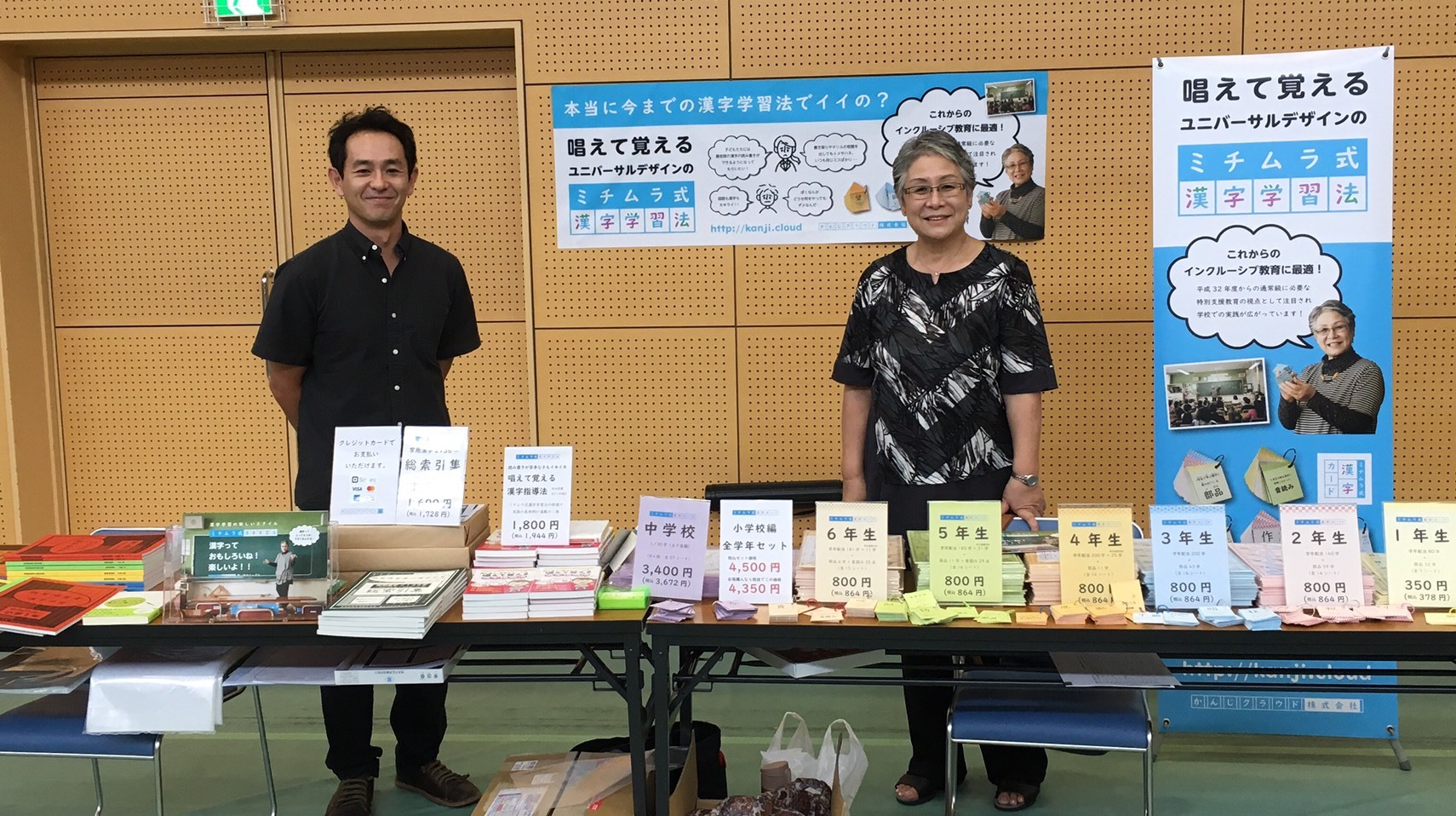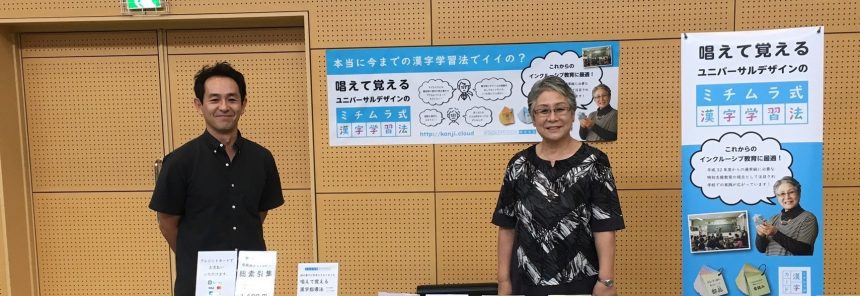
We have been learning kanji since we were children as a matter of course. In most cases, we have studied them by repeatedly writing them in a notebook. However, there are people who have questioned this method of learning by writing.
That person is Shizue Michimura of Kanji Cloud Co., Ltd.
Mr. Michimura worked at Fukui Prefectural School for the Blind and Yokohama Municipal School for the Blind for a total of 28 years, and for 13 years he created and provided teaching materials for "Kanji Learning for the Visually Impaired." As a result, he felt that blind children were able to enjoy learning kanji and broaden their world of language. Later, while working at a regular elementary school, he questioned the traditional kanji teaching method of simply having students write kanji, and created the "Michimura-style Kanji Cards," which teach kanji by reciting them. In 2018, he founded Kanji Cloud Inc. with his son, Tomoharu, and provides kanji cards and e-books, "Kanji e-Books."
In recent years, its use has become more widespread as an effective learning method even for children who are not good at kanji, and at training sessions we also convey teaching know-how from the perspective of special needs, as well as the importance of approaching kanji instruction with a clear vision for the nine years of elementary and junior high school.
Michimura's Kanji Learning MethodWhat is it?
This is a kanji learning method in which you "recite and memorize" the combinations of kanji parts, making it easy for children who just can't seem to master kanji no matter how many times they write them, children who take many times longer to do their kanji homework, and children who are not good at kanji and hate writing them.
The book is packed with ideas to make learning kanji fun, such as explaining the meanings, origins, and usage of kanji parts, including radicals, and learning kanji parts will make learning kanji much easier in the upper grades and beyond.
We also provide two teaching materials that concretely embody this learning method.
Michimura-style Kanji Cards
Kanji cards are teaching materials that teach how to read and write kanji by alternating between reciting the reading and writing instructions written on both sides. They are designed to break down kanji into parts so that they can be memorized by reciting them rhythmically.
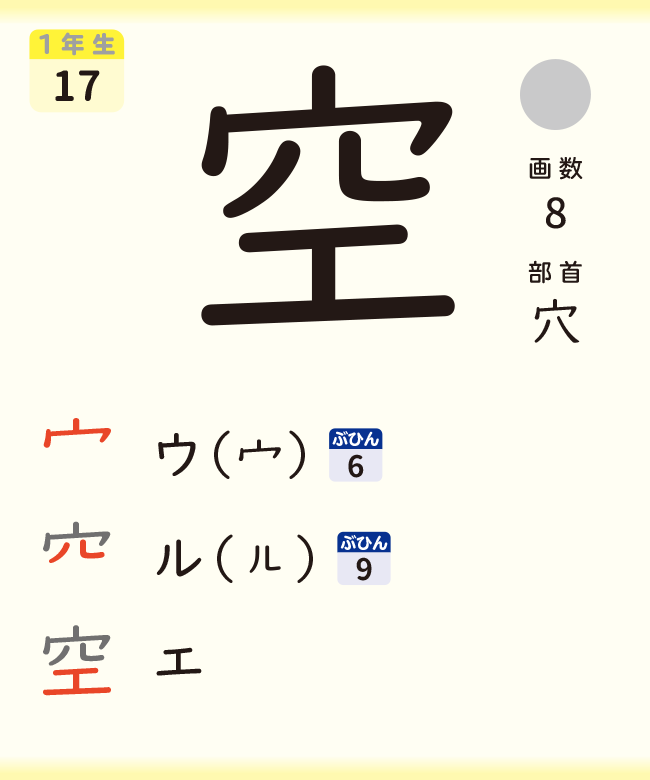
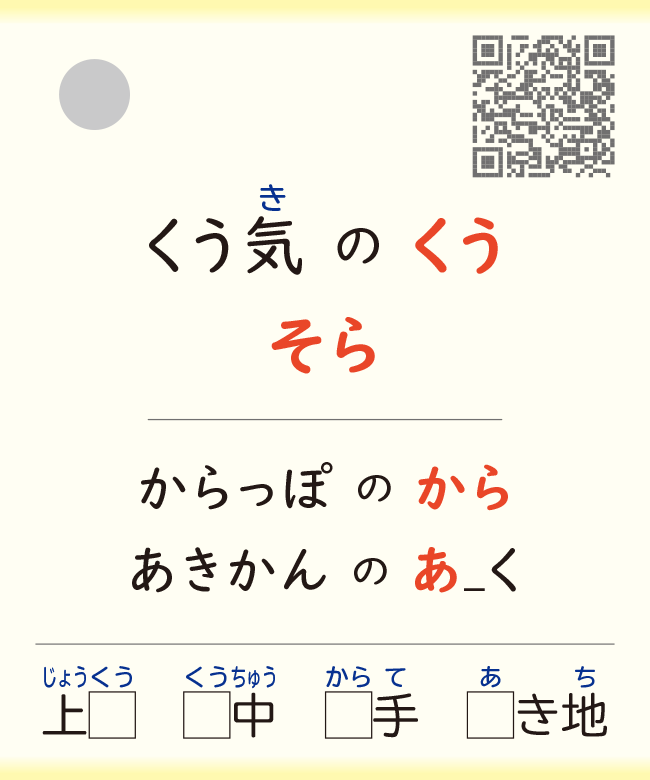
Provided by: Kanji Cloud Co., Ltd.
Kanji e-book
The Kanji e-book is an e-book that lets you learn kanji in a fun way by reciting audio while looking at how the parts fit together. Through image photographs, you can learn many words that use the kanji, just like in an illustrated encyclopedia. It also contains lots of mini facts that will pique children's curiosity, such as the meanings of the kanji parts and the origins of kanji. It draws children into the fun world of kanji.
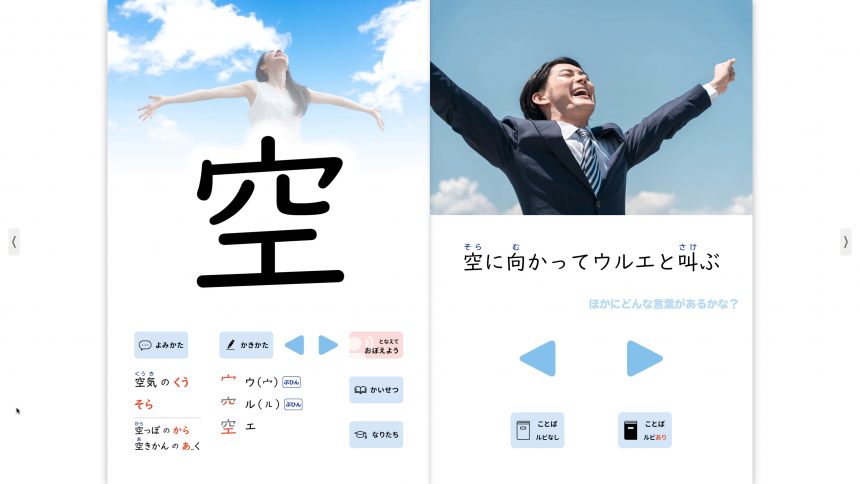
Michimura's Kanji Learning Method e-book with audio won the 2021 Good Design Award
Morisawa: I have the impression that schools for the blind mainly teach Braille, but could you tell us the background behind why you started to focus on kanji and develop teaching materials for it?
Professor Michimura:After graduating from university, I worked at a school for the blind for a total of 28 years.
In schools for the blind, lessons were taught using "Braille" for blind children and "enlarged text" for children with low vision. However, around 1995, computers began to become widespread, and by the year 2000 the world of education had changed dramatically. The age of information education had arrived!
Braille input on the keyboard has become possible, allowing visually impaired people to exchange information on computers. In addition, full Roman alphabet input allows users to type without touch.
However, Braille is entirely written in kana, so blind children who had never been exposed to kanji had no knowledge of it.
When using the text-to-speech function, the kanji candidates for the characters you input are read out loud, but there are many homonyms, and children who don't know kanji can't choose the correct word. That's why I thought that even children who are completely blind need to develop kanji skills that will connect them to the world of information education.
I felt that these children would absolutely need the ability to learn kanji in order to survive in this day and age.
Then, with the help of various grants, I created kanji teaching materials for students at a school for the blind.
Reference: Association for Supporting Braille Learning "Kanji learning for the visually impaired』
Because the students at the school for the blind are blind, it is impossible for them to learn kanji by writing them down as is commonly done, so we made an effort to make sure that they had fun learning kanji. The children who learned kanji in this way were able to read sentences and imagine the kanji, and were able to grasp the meaning of the sentences more deeply!
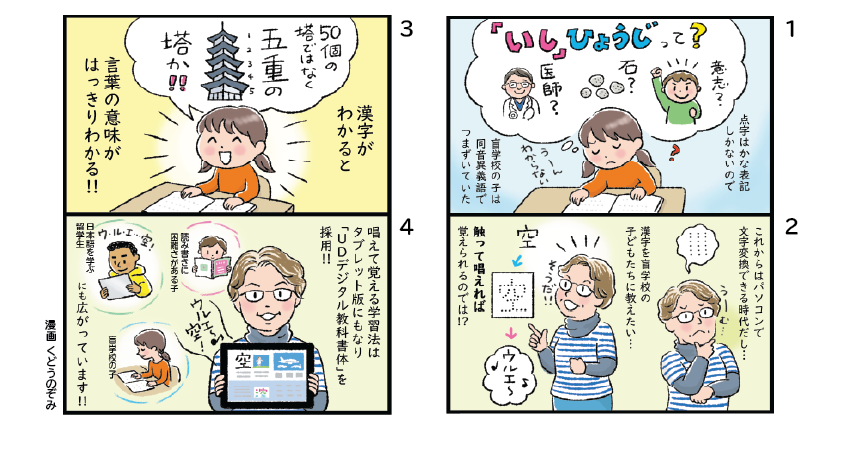
Morisawa: I now understand the need for visually impaired children to learn kanji.
The idea of "learning in a fun way" was born at a school for the blind.
Professor Michimura: However, when I was transferred to a regular elementary school, I found myself in a situation where everyone hated kanji and hadn't yet fully grasped the joy of learning it. When I told them, "I'll give you some kanji homework," they would respond with a dissatisfied "Huh?"
The children at the school for the blind are very eager to learn kanji, saying "Teacher, please teach me more!", but the elementary school students in regular classes hate kanji and run away from it. Seeing this reality, I thought, "Okay, I'll try to adapt this fun kanji learning method for the school for the blind for use in regular elementary schools in my own way."
Morisawa: It was the beginning of kanji cards. Morisawa fonts are used in kanji cards and the electronic learning material "Kanji e-Book."
Professor MichimuraFonts are very important for teaching materials. In the early 2000s, when computers first started to become popular, there were very few fonts available on computers. In the world of education for the visually impaired, round gothic fonts were considered to be the best fonts.
Mincho is a typeface that is familiar to most people, but it has thin horizontal lines and triangles (scales) at the end of each stroke. This makes it difficult to tell how many horizontal lines there are. Nowadays, there is "BIZ UD Gothic", which means the enclosed spaces are wider and no longer collapsed, but the Gothic fonts of that time made simple characters easy to read, but characters with many strokes were collapsed and difficult to read. In contrast, Maru Gothic fonts are relatively large and less collapsed, with soft, gentle corners, which made them very popular with children. But there are some differences from the handwriting they teach in school...
From this perspective, even if we tried to create kanji teaching materials using data, there were very few fonts to choose from at the time.
I had been putting up with the font issue for a long time, but then the "UD Digital Textbook Font" came along! The UD Digital Textbook Font is a textbook font that can be used in schools, and is designed with uniform line thickness, making it easy to read even for people with difficulties such as low vision or dyslexia.
And one more thing:Yuyu textbook body" is also a good choice, as there isn't much difference in the thickness of the vertical and horizontal lines, and the brush strokes are written in accordance with the number of strokes, which I thought would be easy to accept in the educational field. My son, who co-founded Kanji Cloud Inc. in January 2018, discovered these two fonts and has been steadily recreating all of the kanji cards I used to make in Excel using these two fonts. Meanwhile, I always introduced the UD Digital Textbook Font at training sessions around the country. At the time, the font was virtually unknown, but the teachers who attended the training sessions raved about it and began using it in teaching materials and school newsletters.
Morisawa: It took some time for UD Digital Textbook Font to gain recognition after it was included in Windows 10 in 2017, but recently it has become a well-known font in the educational field. I think this is thanks to teachers like Michimura-sensei who have spread the word about it. Thank you!
Tomoharu: Nowadays, with the introduction of ICT in the educational field, teachers' perception of typefaces is changing.UD Gakusan Maru GothicWith the introduction of ", consideration has also been given to children with special needs such as dyslexia, and the UD Digital Textbook Font has been used for the model kanji parts that are most important to memorize, while the UD Gakusan Maru Gothic font has been used for the main text that explains the explanations and origins.
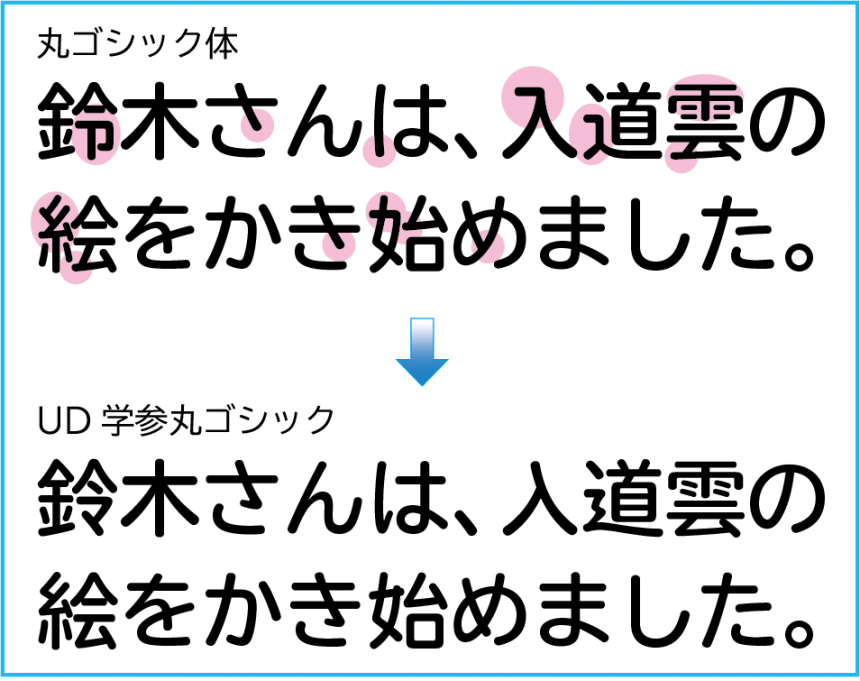
The UD Digital Textbook Font takes into consideration the stroke order based on the shape of the calligraphy, and the detailed design is consistent with the same parts, so I think it will be easy for children to recall the parts they learned before. UD Gakusan Maru Gothic contrasts sharply with the UD Digital Textbook Font, making it clear at a glance that this is an explanation or commentary section, making it useful for design.
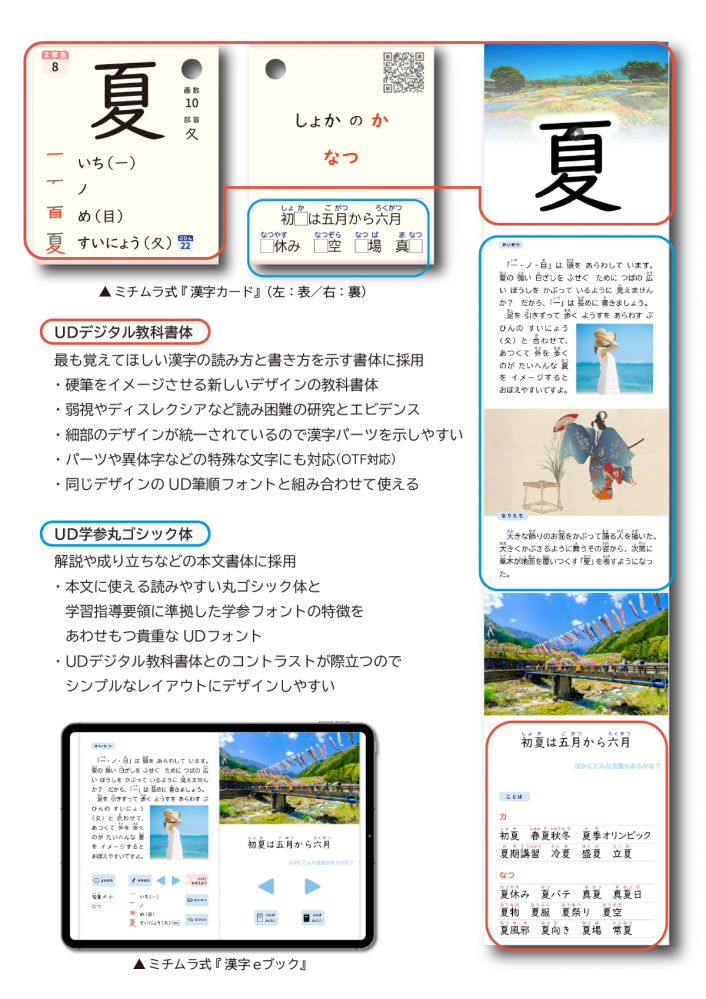
Provided by: Kanji Cloud Co., Ltd.
Morisawa:The Kanji e-Book was created by your son, right?
Tomoharu: Yes. I used my experience working at a publishing company to express my mother's wish that her child could learn kanji in this way. Because the Kanji e-Book is an e-book, it can include many images of the kanji. Some children are attracted to this and become interested in kanji.
The "Kanji Cards" and "Kanji e-Book" also use the UD Digital Textbook's "stroke order font." By looking at the stroke order font and arranging the kanji parts as you recite them aloud, you can complete the kanji.
For example, the page for the character "summer" in the Kanji e-Book is spoken like this:
"Ichi" "No" "Me" "Suinyo"
This way, the children can recite the kanji out loud, just like they would with the audio, and they can remember the shape of the kanji.
Professor Michimura: Another thing I find interesting when learning kanji is the origin of the kanji. For example, "name" (name). When you recite the parts aloud in the Kanji e-Book, it becomes "evening" (yuu) and "mouth" (kuchi).
Do you know why we use "yuu" (evening) and "kuchi" (mouth)?
First of all, the character for "yu" (evening) represents a crescent moon. When the moon comes out in the evening, it's dark and you can't see people's faces very well, so people would announce their own names out loud, and so the character came to mean "name." Interesting, right?
One more thing: when reading, it's important to remember the on and kun readings at the same time.
I believe that being able to "read" kanji is absolutely necessary, followed by being able to "use" them. "Writing" is only a small part of "being able to use" kanji, and the majority of kanji is "being able to use it if you can recognize and select it." This is something that many people in this day and age can truly understand. And yet, the reality is that schools still only require students to write kanji, and neglect "reading instruction."
By learning the on-yomi and kun-yomi readings as a set, even children with low vision or who have difficulty perceiving the shape of characters can connect in their heads the words they normally hear with the kanji they are currently studying and recognize them.
It's very important.
Morisawa:You've come up with a lot of different ideas.
Professor Michimura: I don't think learning kanji means just repeating kanji drills over and over again.
Children who have a tendency to be bad at these things end up hating school because of learning kanji. Instead, I want them to learn in a more fun and efficient way.
For example, a child who has difficulty writing a single character repeatedly but enjoys puzzles may find it easier to remember kanji by combining their parts like a puzzle. A child who enjoys making up stories can create their own favorite story using the origins of kanji and image pictures.
That's the kind of learning I've always aimed for. It's okay if you can't write the stops, strokes, and strokes properly. As long as the structure is correct and the character looks like it should. I would like to see that level of diversity cultivated.
Morisawa:Recently, awareness of developmental disorders, learning disabilities, dyslexia, etc. has been spreading.
Professor Michimura: Currently, the Michimura method is becoming quite popular for use in learning for children with a variety of characteristics.
It has received a great response from academic societies that provide learning support to children with special needs, and has also begun to attract the attention of international students studying Japanese.
We live in an age where tablets are distributed to every student, so it would be nice if more diverse learning methods were allowed. Children who are not good at kanji don't have to write them by hand. You can even find the kanji for an address by entering the numbers in a postal code search. We live in an age where this is allowed.
Therefore, when learning kanji, I would like you to carefully consider the purpose in line with the current era.
There are many ways to acquire the ability to "use" kanji, so by getting a child interested in kanji in a way that they enjoy and are good at, they will ultimately be able to increase their vocabulary. "Being able to focus attention on the world of words, and to be able to use words to receive and send" - I believe this is the main purpose of kanji education.
MorisawaBefore the interview, I wondered, "What does it mean to study kanji at a school for the blind?" But after listening to Professor Michimura's talk, I was able to better understand the significance of studying kanji.
Learning kanji leads to the acquisition of "words," which in turn leads to richer communication and the ability to live. I am once again delighted that Morisawa's characters can help with this, and it has given me the opportunity to further consider the meaning of our company motto, "Contributing to society through characters." Thank you very much, Professor Michimura!
It can be used with the "UD Digital Textbook Font" service (58 UD fonts available for 330 yen per month) used in teaching materials.
For details on MORISAWA BIZ+Here
If you would like students or teachers to use UD fonts or would like to consider introducing them to your school organization, please contact us using the form below.
When introducing UD fonts to a school organization, we are also happy to provide UD font training for teachers, Q&A sessions, and consultations on teaching materials upon request.
It is estimated that 8.8% of children in elementary and junior high schools are suspected of having developmental disorders, and 6.5% children are suspected of having learning disabilities, including dyslexia. This means that in a class of 40 students, two or three children may have dyslexia.
(Source: "Survey Results on Children and Students Requiring Special Educational Support Enrolled in Regular Classes (2022)" issued by the Ministry of Education, Culture, Sports, Science and Technology on December 13, 2022)
Taking this background into consideration, Morisawa will use the power of letters to support the creation of an environment where everyone can learn freely!

